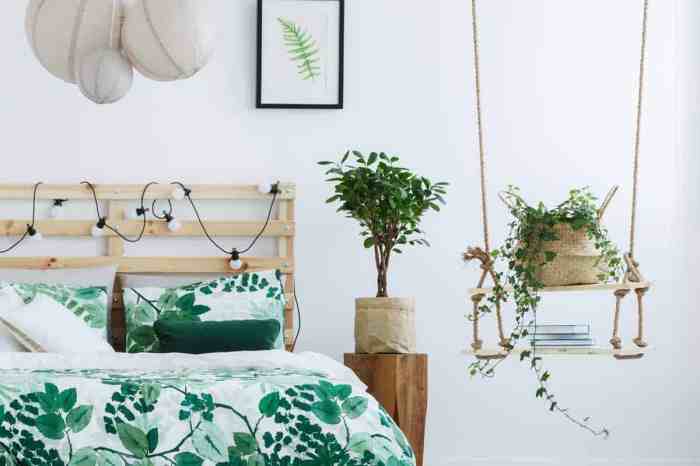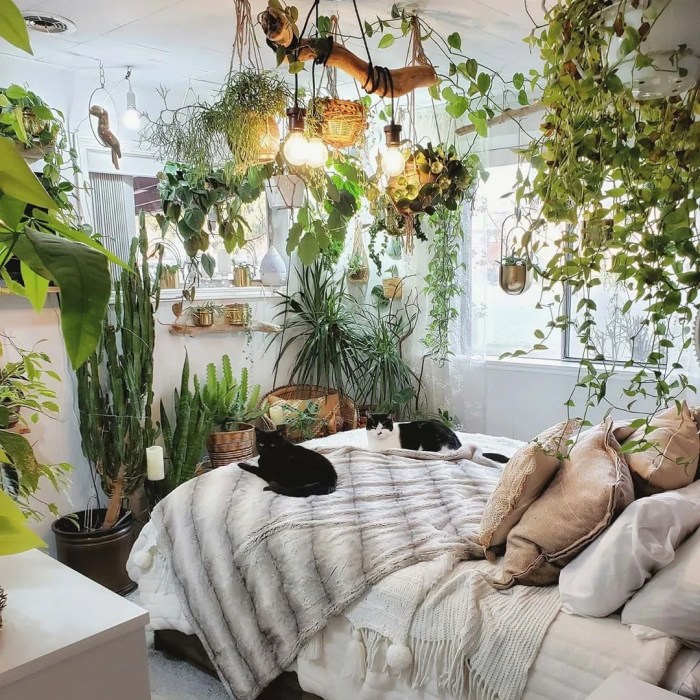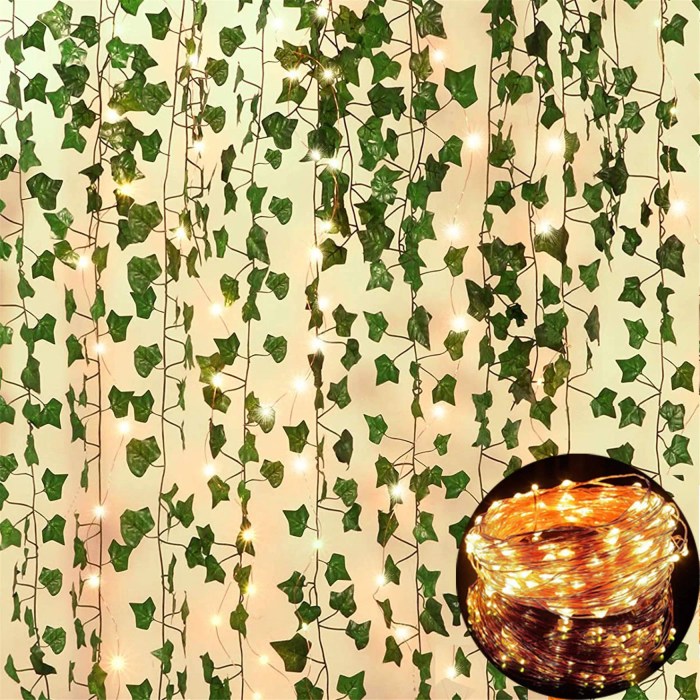Hanging plants for bedroom – Hanging plants have become increasingly popular for bedrooms, offering a unique blend of style and functionality. From purifying the air to reducing stress levels, these plants can transform your sleeping space into a more comfortable and inviting environment. In this guide, we’ll explore the varieties of hanging plants suitable for bedrooms, provide design considerations, discuss care and maintenance, and share creative display ideas.
With their trailing vines and lush foliage, hanging plants add a touch of nature to your bedroom, creating a sense of tranquility and well-being. They can complement any décor style, from bohemian to minimalist, and can be displayed in various ways to suit your space.
Varieties of Hanging Plants

Hanging plants bring a touch of nature and tranquility to any bedroom, adding beauty and improving air quality. From trailing vines to cascading foliage, there are numerous varieties of hanging plants suitable for bedrooms, each with unique characteristics and benefits.
Here are some popular hanging plants for bedrooms, along with their scientific names and brief descriptions:
Pothos
- Scientific name: Epipremnum aureum
- Description:Pothos is a low-maintenance vine with heart-shaped leaves that come in various shades of green, yellow, and white. It is known for its air-purifying abilities and ability to tolerate low light conditions.
Spider Plant
- Scientific name: Chlorophytum comosum
- Description:Spider plants are known for their long, arching leaves that produce plantlets at the tips. These plants are easy to care for and can help purify the air, removing pollutants like formaldehyde and xylene.
String of Pearls
- Scientific name: Senecio rowleyanus
- Description:String of pearls is a unique succulent with trailing stems adorned with spherical, pea-like leaves. It is a low-maintenance plant that prefers bright, indirect light and well-draining soil.
Design Considerations: Hanging Plants For Bedroom
When selecting hanging plants for a bedroom, it is crucial to consider their aesthetic impact in relation to the room’s existing décor. The size, shape, and color of the plants should complement the furniture, wall colors, and overall ambiance of the space.
Choosing plants that harmonize with the existing color scheme creates a cohesive and visually appealing display. For instance, plants with vibrant foliage can add a touch of color to a neutral-toned bedroom, while plants with variegated leaves can complement a room with bold patterns.
Plant Size and Shape
The size and shape of hanging plants should be carefully considered to ensure they do not overwhelm or obstruct the room. Smaller plants are suitable for smaller bedrooms, while larger plants can make a statement in more spacious rooms. Plants with trailing or cascading foliage can add a touch of drama, while upright or bushy plants can create a more structured look.
Color and Texture
The color and texture of hanging plants can significantly impact the overall mood of a bedroom. Plants with dark green foliage can create a sense of tranquility, while plants with variegated or brightly colored leaves can add a touch of vibrancy.
Plants with soft, velvety leaves can create a cozy atmosphere, while plants with spiky or textured leaves can add a touch of interest.
Care and Maintenance

Maintaining hanging plants in bedrooms requires specific care and attention to ensure their health and longevity. Understanding their water, sunlight, and humidity requirements, as well as potential challenges and solutions, is crucial for thriving indoor greenery.
Watering frequency depends on the plant species, soil type, and room temperature. As a general rule, water when the top inch of soil feels dry to the touch. Avoid overwatering, which can lead to root rot and yellowing leaves.
Hanging plants often receive less sunlight than floor plants. Choose species tolerant of indirect or low light conditions. Rotate plants occasionally to ensure even light distribution.
Humidity levels in bedrooms can be low, especially during winter. Use a humidifier or place plants on a tray filled with pebbles and water to increase humidity. Misting plants can also help, but avoid over-misting, which can promote fungal growth.
Challenges and Solutions, Hanging plants for bedroom
- Yellowing leaves:Can indicate overwatering, underwatering, or nutrient deficiency. Adjust watering schedule or fertilize accordingly.
- Pests:Aphids, mealybugs, and spider mites can infest hanging plants. Treat with insecticidal soap or neem oil.
- Overwatering:Excess water can lead to root rot and yellowing leaves. Ensure proper drainage by using well-draining soil and a pot with drainage holes.
Creative Display Ideas

Hanging plants can transform a bedroom into a lush oasis, adding a touch of nature and tranquility to the space. Beyond traditional hanging baskets, there are numerous creative ways to showcase these verdant beauties, elevating the bedroom’s ambiance and creating a unique visual appeal.
Hanging plants can bring a touch of nature and tranquility to your bedroom. If you’re looking for a way to add some greenery to your space without taking up too much floor space, consider using wall plant hangers indoor . These hangers come in a variety of styles and materials, so you can find one that fits your decor and needs.
Plus, they’re a great way to show off your favorite plants and add a touch of personality to your bedroom.
Macrame Hangers
Macrame hangers are a bohemian and stylish way to display hanging plants. These intricately knotted cords create a beautiful and airy support for plants, adding a touch of texture and warmth to the room. They come in various lengths and designs, allowing for customization and versatility.
Wall-Mounted Shelves
Wall-mounted shelves provide a practical and space-saving solution for hanging plants. They can be installed at different heights and depths, creating a tiered display that showcases plants of varying sizes and shapes. Shelves can be made of wood, metal, or glass, complementing different bedroom styles.
Ceiling Hooks
Ceiling hooks are a simple yet effective way to suspend hanging plants from the ceiling. They allow for maximum vertical space utilization, creating a dramatic and eye-catching display. Hooks can be made of metal or wood, and their finish can match the bedroom’s decor.
Vertical Gardens and Plant Walls
For a larger-scale display, vertical gardens and plant walls transform bedrooms into lush indoor sanctuaries. These living walls consist of multiple hanging plants arranged vertically, creating a stunning focal point and purifying the air. They can be customized to fit any space and style.
Suspended Terrariums
Suspended terrariums combine the beauty of hanging plants with the enclosed ecosystem of a terrarium. These glass containers create a miniature world for plants, providing a unique and captivating display. They can be hung from the ceiling or placed on shelves, adding a touch of whimsy to the bedroom.
Benefits of Hanging Plants in Bedrooms
Hanging plants in bedrooms is gaining popularity due to their aesthetic appeal and potential health benefits. Scientific evidence suggests that having plants in the bedroom can significantly improve air quality, reduce stress levels, and enhance sleep quality.
Plants act as natural air purifiers, removing harmful pollutants and toxins from the air. Studies have shown that certain plants, such as spider plants, peace lilies, and snake plants, are particularly effective at removing common indoor air pollutants like benzene, formaldehyde, and trichloroethylene.
The presence of plants in the bedroom has also been linked to reduced stress levels. Studies have found that interacting with plants can lower blood pressure, heart rate, and cortisol levels, which are all indicators of stress. The calming effects of plants can create a more relaxing and peaceful sleep environment.
Improved Sleep Quality
Hanging plants in the bedroom can also contribute to improved sleep quality. The presence of plants in the bedroom has been shown to promote relaxation and reduce anxiety, which can lead to better sleep. Additionally, plants release oxygen at night, which can help to improve air quality and create a more comfortable sleeping environment.
Hanging plants can add a touch of nature and serenity to any bedroom. However, if you’re looking for a low-maintenance option, consider fake hanging plants indoor . These realistic-looking plants offer the same aesthetic appeal without the need for watering or sunlight.
Whether you prefer lush ferns, trailing ivy, or cascading succulents, there’s a fake hanging plant to complement any bedroom décor.
Many individuals have reported experiencing positive effects from having hanging plants in their bedrooms. For example, one study found that participants who slept in a room with plants reported improved sleep quality, reduced stress levels, and increased feelings of well-being.
Overall, the scientific evidence and personal experiences suggest that hanging plants in bedrooms can provide numerous benefits, including improved air quality, reduced stress levels, and enhanced sleep quality. By incorporating plants into the bedroom, individuals can create a more comfortable, relaxing, and healthier sleep environment.
Last Word
Whether you’re looking to improve your sleep quality, purify the air in your bedroom, or simply add a touch of greenery to your space, hanging plants are an excellent choice. With proper care and maintenance, these plants can thrive in your bedroom, providing years of beauty and benefits.
Question Bank
How often should I water hanging plants in my bedroom?
The watering frequency depends on the type of plant and the humidity levels in your bedroom. Generally, water when the soil feels dry to the touch.
What are some common problems with hanging plants in bedrooms?
Common problems include yellowing leaves (due to overwatering or lack of light), pests, and root rot. Proper care and maintenance can prevent these issues.
Can hanging plants help improve sleep quality?
Yes, studies have shown that certain hanging plants, such as lavender and spider plants, can release calming scents that promote relaxation and improve sleep.